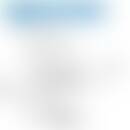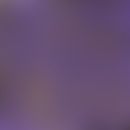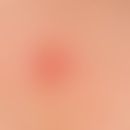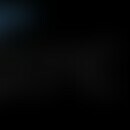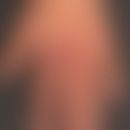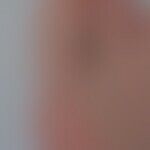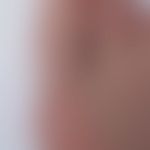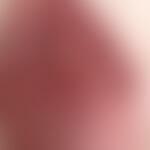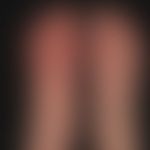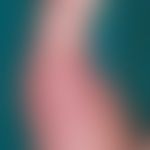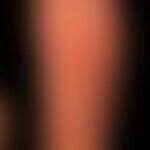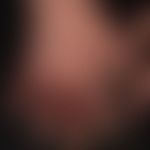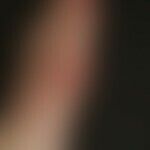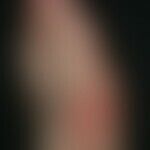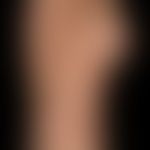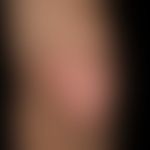Synonym(s)
DefinitionThis section has been translated automatically.
Clinical manifestation of primary or secondary hyperuricemia in the form of acute and chronic arthritis and deposition of uric acid salts from supersaturated synovial fluid in the joints (see also uric acid, see also gout tophi). The uric acid level is decisively influenced by age, gender and diet. The solubility limit of sodium urate in plasma is approx. 6.8 mg/dl (400 µmol/l); the upper limit for the reference range of uric acid is 7.0 mg/dl (416 µmol/l) for men and 6.0 mg/dl (357 µmol/l) for women.
Occurrence/EpidemiologyThis section has been translated automatically.
In industrialized countries, around 20 % of men have hyperuricemia > 7 mg/dl (> 416 µmol/l). In women, uric acid usually only rises after the menopause (estrogens with a uricosuric effect cease); before the menopause, hyperuricemia is rare and then of secondary origin.
The prevalence of arthritis urica in industrialized countries is approx. 2% of adults (m: f to 9: 1) and increases with age.
The risk of a gout attack increases with increasing levels of hyperuricemia: incidence rate at values > 9 mg/dl (> 535 µmol/l): Approx. 5 % per year.
The risk of nephrolithiasis is 0.2 % per year in asymptomatic hyperuricemia and 0.8 % per year in gout patients.
You might also be interested in
EtiopathogenesisThis section has been translated automatically.
Primary gout (90% of cases):
- Autosomal dominant inherited purine metabolism disorder. Disturbance of tubular uric acid secretion in the kidney. Reduced uric acid clearance: manifests itself with a purine-rich diet and obesity. Family history is common.
- Overproduction of uric acid (about 1% of cases):
- Deficiency of the enzyme hypoxanthine-guanine-phosphoribosytranferase (HG-PRT)
- Lesch-Nyhan syndrome (X-linked recessive inherited disease, hyperuricemia, tendency to self-mutilation)
- Kelley-Seegmiller syndrome (activity of HG-PRT reduced (to 1-20%) hyperuricemia, kidney stones, neurological symptoms but no self-mutilation.
Secondary gout (10% of cases):
- Increased uric acid formation in hemolytic anemias, leukemias, cytostatic or radiotherapy of tumors.
- Reduced renal uric acid excretion in kidney diseases, ketoacidosis (fasting, diabetes mellitus), intake of pharmaceuticals (saluretics, loop diuretics, thiazides).
ManifestationThis section has been translated automatically.
Primary gout: Mainly occurring in middle-aged and older men, in women practically never before the menopause. Frequently associated with obesity, diabetes, lipometabolic disorders.
Comorbidities are: hypertension (69%), hyperlipidemia (43%), diabetes mellitus (32%), impaired renal function/eGFR<60ml/min (16.45, thyroid dysfunction (7.3%), depression (7%).
ClinicThis section has been translated automatically.
I. Acute attack of gout: often occurs after an opulent meal or copious consumption of alcohol, but also completely spontaneously without any recognizable cause. Sudden onset, highly painful monarthritis (usually of the metatarsophalangeal joint of the big toe, so-called podagra), more rarely of the ankle and tarsus (approx. 15%), the knee joint (gonagra: 10%) or metatarsophalangeal joint of the thumb (so-called chiragra) with severe, continuous, spontaneous pain or pain on pressure, combined with redness and swelling. If particularly severe, fever, chills and general signs of inflammation. Hyperuricemia is not obligatory in an acute attack of gout (uric acid level check 2-3 weeks later).
Chronic stage II: Chronic, progressive, mutating arthritis of the peripheral joints. Occurrence of gouty tophi on the skin. The occurrence of gouty panniculitis is rarely observed (Gaviria JL et al. 2015).
DiagnosisThis section has been translated automatically.
The following criteria (ARA criteria) are used to classify acute gouty arthritis (modified according to Wallace 1997):
A) Urate crystals in synovial fluid
B) Urate crystals in Tophus
C) Various
- Recurrent acute arthritis
- Ignition maximum within 24 hours
- Monarticular infestation
- redness of the metatarsophalangeal joint of the big toe
- pain, swelling of the metatarsophalangeal joint of the big toe
- Unilateral infestation of metatarsophalangeal joints of the toes
- Unilateral infestation of the tarsal
- Tophus
- Hyperuricemia - uric acid i.S. increased ( > 6.4 mg/dl)
- Asymmetrical swelling in the X-ray image
- Subcortical cyst without erosion
- Abacterial joint effusion
Arthritis can be classified as uric arthritis if at least one of criteria A, B, C is met, where C is considered to be met if 6 of the characteristics listed in 1-12 apply.
Complication(s)(associated diseasesThis section has been translated automatically.
General therapyThis section has been translated automatically.
Internal therapyThis section has been translated automatically.
Acute gout attack: Indometacin (e.g. Amuno) 3 times 50 mg/day or acemetacin 120-180 mg/day (e.g. Rantudil forte 2-3 Kps./day). Alternatively, naproxen 500-1250 mg/day divided into 2-3 ED p.o. or colchicine (Colchicum Dispert Drg.) 1 mg hourly for 4 hrs, then 0.5-1 mg every 2 hrs until symptoms subside. Maximum daily dose 8 mg. Side effect: Diarrhea common (do not discontinue therapy, treat with Imodium). Improvement of arthritis under colchicine usually prompt. Repeat therapy the next day with half the dose. On the 3rd day 1.5 mg colchicine/day. Duration of treatment: 5 days. Lower dose in renal insufficiency.
Alternative: Ibuprofen (2x 600mg), if necessary combined with prednisolone orally (50mg); reduce descending dosage to 0 within 1 week.
Chronic stage: Allopurinol (e.g. Zyloric) 300-600 mg/day, possibly uricosurics such as probenecid.
NaturopathyThis section has been translated automatically.
Dietary therapy: Less sausage and meat, especially no poultry skin and offal; no alcohol .
see also under drinking cure.
see also under Kneipp compresses.
Cave: certain vegetables such as asparagus, spinach, Brussels sprouts, legumes, soy products, poppy seeds, dried fruits, shells and crustaceans, white flour products, sweet mueslis and pastries, processed cheese, porcini mushrooms, black salsify, green peas, yeast!
In addition to acupuncture, mainly excretory procedures are used.
Acute gout attack: leeches, small phlebotomies
In acute gout attacks, therapies with the patient 's own blood as a mixed injection are also described: 2 ml of the patient's own blood with 2 ampoules of Traumeel® and 1 ampoule of Restructa per injectione on day 1, 2 and 4, then 2 x / week.
Autologous blood with heme activator: autologous blood with 1 ampoule of Traumeel and 1 ampoule of Restructa pro injectione on day 1, 2 and 5, and 2 x / week.
For chronic symptoms: own blood with heme activator (like acute gout attack) and Harpagophytum D3 DHU or with injection solution Ledum Pflüger and Harpagophytum D2 injection solution Pflüger.
Gouty tophi on the big toes: Cantharid plaster, see there: Authors are reluctant to this therapy!
Acute gout attack: hydrotherapy with cold compresses or water pours: cold water flowing over the painful joint until pain is reduced/freed, if necessary ice compresses - caution: danger of frostbite!
chronic complaints:
- Cold Kneipp treatments: Washing, watering, partial baths, sauna 1 x / week, mud packs of the affected joints, also hot compresses, e.g. with birch leaves.
- Exercise therapy: endurance gymnastics, metabolic gymnastics, swimming, cycling, walks, gardening, also massages.
- Balneotherapy: radium baths, sulfur baths, additionally drinking cure with sodium hydrogen carbonate (Bullrich acid bases balance tablets)
- Phytotherapy: Colchicine, see also under Internal therapy, Colchici semen, Colchicum autumnale - Autumn crocus : e.g. Colchicum Dispert® Drg, Colchysat® Bürger drops. Cave Maximum dose 8 mg/day, in case of diarrhea dose reduction! according to empirical medicine respectively without monograph also: Betulae folium, s.a. Avenae stramentum, s.a. Berberidis radicis cortex; Equiseti herba, Fraxini folium, Oleae folii, Taraxaci radix, Taraxaci radix cum herba, s.a. under Quercetin ,Rosae pseudo-fructus cum fructibus; formerly also Oleum Thujae.
- Externally: see also under rosemary, horse chestnut.
- s.a. under Gemmotherapy
A low-purine diet is recommended, e.g. dairy products such as milk, yoghurt and curd cheese, eggs, hard cheese, lots of vegetables (with the exception of purine-rich varieties such as cabbage, green beans, broccoli, spinach, asparagus).
Cereal products and flakes, potatoes, egg noodles, white bread and rice can also be used as low-purine foods.
It is important to drink at least two to three liters of water per day. Unsweetened herbal and fruit teas or coffee are also permitted.
TablesThis section has been translated automatically.
Purine table: Foods that may be eaten in gout (values calculated as uric acid/100g)
- Milk 0 mg/100g
- Yogurt 0 mg/100g
- Curd cheese 0 mg/100g
- Tea 0 mg/100g
- Coffee 0 mg/100g
- Egg 5 mg/100g
- Cucumber 7 mg/100g
- Tomatoes 10 mg/100g
- Bell bell pepper 10 mg/100g
- Potatoes 15 mg/100g
- Apples 15 mg/100g
- Pear 15 mg/100g
- Honeydew melon 18 mg/100g
- Watermelon 20 mg/100g
- Cheese 20 mg/100g
- Zucchini 22 mg/100g
- Wheat flour 38 mg/100g
Purine table: Foods to avoid in gout (values calculated as uric acid/100g)
- Sprats 802 mg/100g
- Pork spleen 600 mg/100g
- Oil sardines 480 mg/100g
- Trout 345 mg/100g
- Calf's liver 288 mg/100g
- Goose meat 254 mg/100g
- Pork cutlet 211 mg/100g
- Tuna in oil 204 mg/100g
- Peas 180 mg/100g
- Brussels sprouts 170 mg/100g
- Lentils 160 mg/100g
- Cauliflower 45 mg/100g
- Asparagus 25 mg/100g
- Fillet of beef 153 mg/100g
- Beer, light with alcohol 15 mg/100g
LiteratureThis section has been translated automatically.
- Gaviria JL et al. (2015) Unusual Dermatological Manifestations of Gout: Review of Literature and a Case Report. Plast Reconstr Surg Glob Open 3:e445
- Richette P et al.(2016) 2016 updated EULAR evidence-based recommendations for the management of gout. Ann Rheum Dis. 2016 Jul 25. doi: 10.1136/annrheumdis-2016-209707.
- Scherer M et al. (2016) Association between multimorbidity patterns and chronic pain in elderly primary care patients: a cross-sectional observational study. BMC Fam Pract 17:68.
- Tzeng HE et al.(2016) Gout increases risk of fracture: A nationwide population-based cohort study. Medicine (Baltimore) 95:e4669.
- Wallace SL et al. (1977) Preliminary criteria for the classification of the acute arthritis of primary gout. Arthritis Rheum 20: 895-900.
- Augustin M et al (1999) Praxisleitfaden Naturheilkunde. S 569-571
- https://www.helios-gesundheit.de/magazin/ernaehrung/news/ernaehrung-bei-gicht/
Incoming links (45)
Adiposity skin changes; Arthritis urica; Asparagi rhizoma; Autumn crocus; Avenae stramentum; Bibernelle large; Calcinosis dystrophica disseminated; Canakinumab; Chiragra; Colchici semen; ... Show allOutgoing links (48)
Acupuncture; Aus ausleitende verfahren; Autologous blood therapy; Autumn crocus; Avenae stramentum; Balneotherapy; Berberidis radicis cortex; Betulae folium; Birch leaves; Bloodletting; ... Show allDisclaimer
Please ask your physician for a reliable diagnosis. This website is only meant as a reference.
